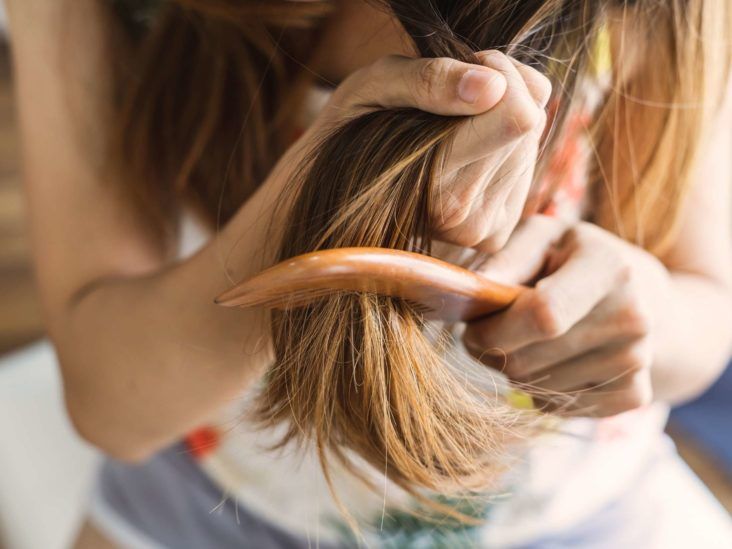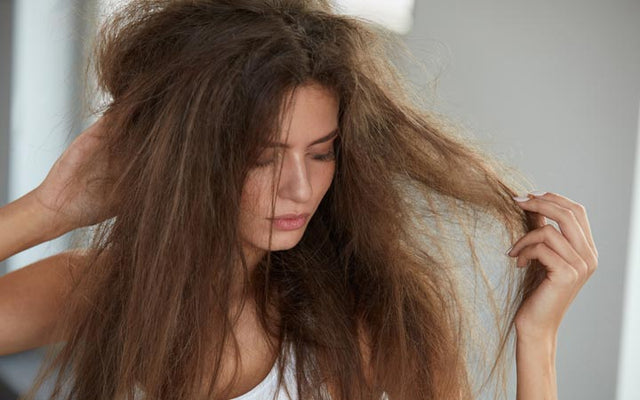Do the words “dry hair”, “split ends”, “breakage” or “frizz” sound familiar? Then you are in the right place. All these words mean hair damage and indicate that your hair needs your attention.
Learn about the different types, causes and ways to repair hair damage in this article.
What Exactly Is Hair Damage?
Hair damage refers to generally to damage that occurs externally. Hair layering is caused by the hair or cuticles. The cuticle opens up and makes the hair shaft more susceptible to further damage.
Damaged hair is visible and obvious.
- Frizzy
- Dry
- Tangled
- Brittle
- Unmanageable
- Rough
- Lacklustre
What Types Of Hair Damage Exist?

1. Dull and dry hair
Damaged hair loses natural oils from the outer layer of the hair. This causes the hair to lose its shine. Shampoos containing harsh chemicals can strip your scalp and hair of its natural oils. Wash your hair less frequently and use shampoos suited to your hair type.
2. Tangling
Damaged hair tends to tangle. Raised cuticles create friction between hair strands and cause them to become tangled. Lack of moisture in your hair can make this situation worse. Brush from bottom to top with a wide tooth comb. Detangling sprays, oils, conditioners and masks will help you with this.
3. Frizz
If the cuticle is not flat, frizz can occur. Frizz can appear on the surface of the hair, in the strand, at the tips or ends of the hair. Humidity and damaged hair can cause frizz. Serums help control frizz.
4. Hair fragility and breakage
Split ends occur when a strand of hair splits into two parts. This can make your hair brittle and prone to breakage. Hair powder, serums and conditioners can eliminate split ends to a large extent.
What Causes Hair Damage?

1. Heat styling
Heat during styling, such as straightening, curling or blow-drying, can open the cuticle and make hair porous . High temperatures are a sure cause of hair damage.
If you need to comb your hair for an important event, you can dry it with a hairdryer. . about 15 cm and use a good thermal protective serum. Also make sure to partially dry your hair with a soft cotton t-shirt before starting heat styling.
2. Bleaching
Bleaching is a process in which hair is lightened one or two shades more than its natural color. The technique consists in dissolving the melanin pigment that gives color to the hair. Bleaching can cause hair to become dry, brittle and rough. It can also affect the elasticity of your hair.
To minimize further damage caused by bleaching, use sunscreen (hats and caps) and moisturizing ingredients on your hair. Furthermore, it protects your hair from chlorinated pool water. This can turn your hair green and strip away more moisture.
3. Chemical dyes
Dyeing your hair to create a fashion trend has a price. The price is hair damage! Yes, hair dye pigments can draw moisture from your hair, leaving it rough. Dry hair is prone to split ends and breakage.
Pro Tip:
- Choose your hair coloring that comes closest to your natural hair color in three shades. Unnatural colors require frequent touch-ups, which means your hair is increasingly exposed to the color.
- The easiest way to minimize damage caused by hair coloring is to do it. rarely. The hair care experts at SkinKraft recommend using shampoos for colored hair and washing your hair less frequently to avoid frequent touch-ups.
How Is Damaged Hair Treated?

1. Hair care routine
Switch to a gentle hair care routine. This requires some research before purchasing shampoo, conditioner, oil and serums. Washing and conditioning your hair is the foundation of any hair care routine.
Make sure you buy products that are free of sulfates, parabens, alcohols, artificial colors and fragrances. I am. Wash your hair regularly to remove dirt, oil and dead skin cells. You can use commercial deep conditioners to repair damaged hair. They contain more effective ingredients and have longer exposure times.
2. Apply hair serum
We can't stress the importance of serums enough. They protect hair from heat styling, control frizz and ensure hair shine. General rule: apply the serum to hair and ends. Application to the scalp may leave hair greasy.
3. Trim your hair
Cut your hair every 6-8 weeks to eliminate or prevent split ends. If left untreated, split ends can cause brittle, dry and damaged hair.
4. Homemade masks
Inexpensive homemade masks can repair damaged hair and make it healthy.
-
Avocado
Use a ripe avocado and an egg to create a hair mask and leave it on for 20 minutes. Avocado is rich in vitamins, minerals and fatty acids: everything you need for healthy hair.
-
Banana
Mix ripe banana with cream cheese or mix with olive oil. Apply this mixture to your hair and scalp. Wash with a mild shampoo. Bananas contain carbohydrates, potassium, vitamins and natural oils necessary to moisturize hair.
-
Eggs
Use the egg whites and half a lemon to obtain a homogeneous mixture. Apply to hair and cover with a shower cap for 30 minutes. Rinse with a mild shampoo. Eggs are rich in proteins and also vitamins A, D and E. They act as a conditioner and restore lost shine. Lemon has an antifungal effect and helps remove product residues from the hair.
5. Hair Oils
Coconut oil is one of the amazing natural hair products. It can penetrate the hair cuticle and repair hair damage.
Olive oil is considered an excellent moisturizer and can help replenish lost moisture in the hair.
Almond oil helps rehydrate dry hair and reduce frizz.
Argan oil is enriched with vitamins E and A. It hydrates the hair and prevents breakage.
Tips For Treating Hair Damage
- Resist the temptation to massage your hair strands with shampoo. Simply massage your scalp and run it through your hair. Using more product to create more lather will cause dryness.
- Wrap your hair in a soft cotton t-shirt that will absorb water. Then air dry your hair.
- Do not brush your hair when it is wet as it becomes sensitive when wet.
- Do not sleep with tight hairstyles such as ponytails and buns.
- Don't sleep with tight hairstyles like ponytails and buns.
- Limit styling, coloring and heat bleaching sessions.
- If your hair is tangled, brush it with a wide-toothed comb after applying conditioner to your hair in the shower.
